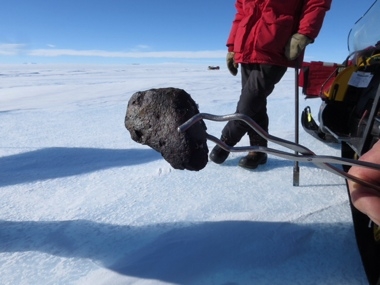 When we look at the sky during the night, we sometime see a star falling and making a streak of light in the atmosphere as it falls. Ultimately, it disappears. It, in fact, disintegrates. Such heavenly bodies falling after disintegration are not stars – they are meteorites. They are of varying sizes.
When we look at the sky during the night, we sometime see a star falling and making a streak of light in the atmosphere as it falls. Ultimately, it disappears. It, in fact, disintegrates. Such heavenly bodies falling after disintegration are not stars – they are meteorites. They are of varying sizes.
Whenever any one of the celestial bodies, while making revolutions, comes nearer to the earth, it is attracted towards the earth due to its force of gravitation. Attraction of the earth increases the velocity of the body and this, in turn, increases friction with the atmospheric air. Consequently, it becomes very hot. As a result of this, hot gases start coming out of it. These gases start burning and the atmosphere is lighted. The sound of friction in the air is heard over long distance. Because of heat and friction, the body disintegrates into small pieces which are scattered in the atmosphere. But some of these meteorites are so big that they are not completely destroyed in the atmosphere and some of their parts fall on the earth.
Meteorites become visible to us only when they are in the atmosphere, at a height of 112 km from the earth. Majority of them are destroyed in the atmosphere by the time they come down to a height of 80 km. Their downward velocity ranges from 160 km to 200 km per sec. They fall down both during the day and the night, but they are not visible during the day because of the bright sunlight.
Meteorites are, in fact, pieces of comets. Whenever the earth approaches the orbit of some comet, some pieces of it are attracted towards the earth. These pieces may be either big or small. The biggest meteorite reaching the earth weighed 37 tons.
There are three kinds of meteorites. The first kind is called the shooting star. A meteor of this kind is like a dim-lighted star. The second is a meteoric stone. It is so big that some part of it reaches the earth. The third kind is the fire ball. Even if it is big, it is destroyed in the atmosphere itself. The outer layer of the meteorites is hot, but their inner layers are cold. Because of the melting of the outer layer, a thin shining layer gets deposited outside. In many meteorites, there are craters like the ones caused on human faces by small-pox. The formation of meteorites is similar to that of ordinary crystalline stones on the Earth. Their crystalline nature suggests that they must have been in molten state at some stage. Quite often the meteorites are composed of stones, iron, nickel and other elements.
The Arizona Meteor Crater measures 1,265 m across and it is 175 m deep. This crater was formed about 25,000 years ago by a meteorite fall.
In India, some meteoric stones are preserved in the museum of Calcutta. However, bigger stones have not been collected. In the US, samples of 672 meteorites have been kept in various museums.
